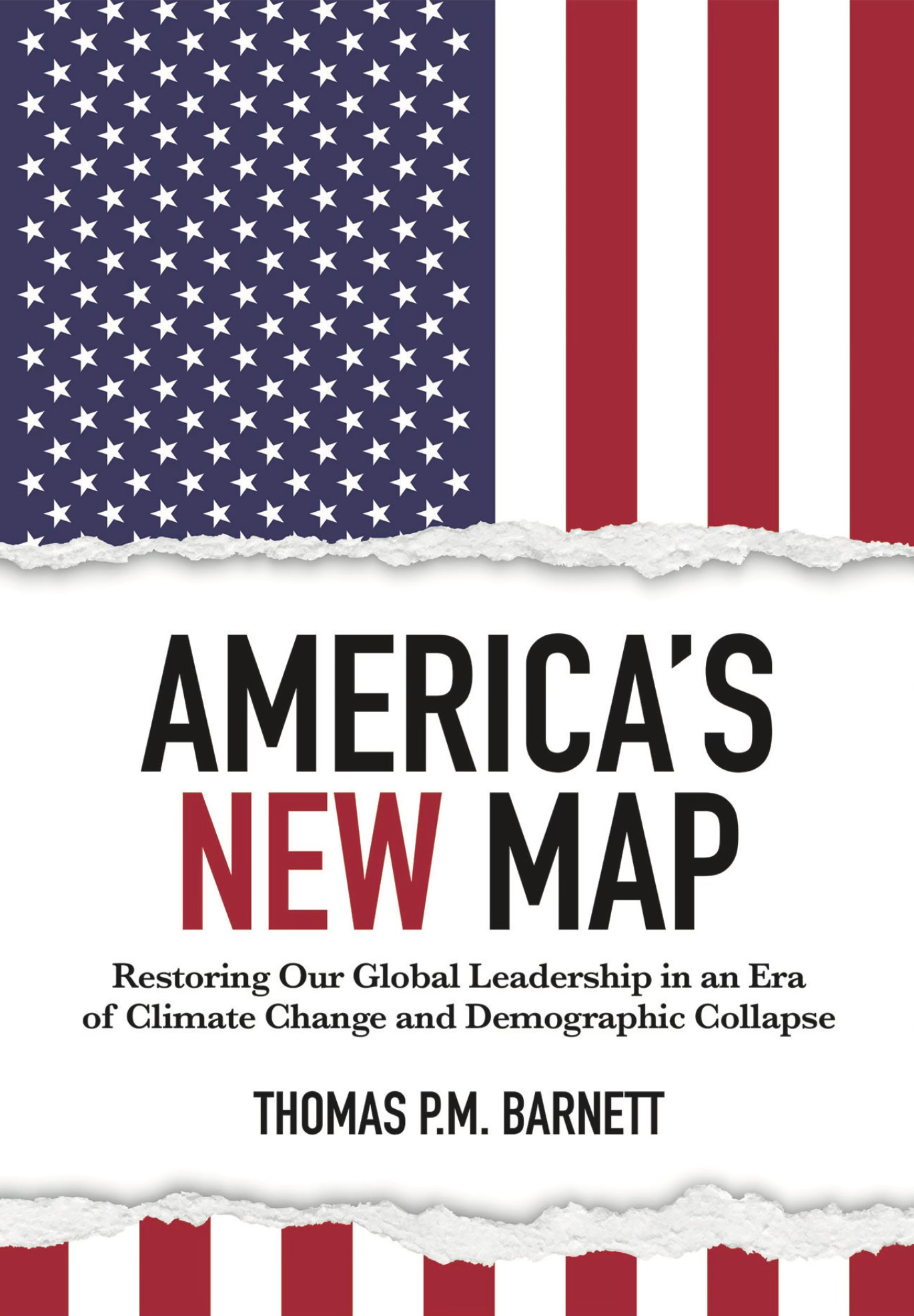"Caste" author Isabelle Wilkerson recognizes America's 50/50/50 journey
In grateful reply, I offer an excerpt from "America's New Map"
The founder of Throughline sent me this link last night to Lawrence O’Donnell’s The Last Word show on MSNBC. Above you will find the clip of note, which I transcribe here:
Lawrence O’Donnell: In the new, updated paperback edition of her New York Times #1 bestseller, “Caste,” Isabelle Wilkerson writes:
A caste system relies on strife and inequity to sustain itself. It programs people to believe they have no stake in the well-being of those they have been told are beneath them, those they are told are unworthy, undeserving. It makes for a less magnanimous society, a built in US-versus-them distance between groups. Because of the caste system, we more readily turn against one another. Because of caste, we insufficiently protect our own. Because of caste, along with other breakdowns in society, our democracy is in danger.
And we're back with Isabel Wilkerson. This new updated version takes us into the present-day battle for the future of American democracy in a way that I didn't anticipate in the first read of the book. [2020 publicaton]
Isabelle Wilkerson: Yeah. I think that what we're seeing right now are the responses to a configuration in our country's demographics that we've never – no one alive could ever anticipate, we don't know what it's like to be in an inversion of the historic demographics of our country, with one group – the dominating majority group that's been in power in the dominant majority for as long as there's been a United States – and the anticipation that the census has set us up for: the anticipation by 2042 or 2045 that historic majority would no longer be the majority. And we also had the first rumblings of that with the 2020 census which indicated that, for the first time in American history, the historic white majority actually fell in number – still the majority by far, but it fell, for the first time in our country's history, and I believe that all of these things are connected.
We're facing an existential crisis as to who we are as a nation, as to what kind of country we wish to be. I think that there's already a growing sense of of alarm on the part of some people … fear, insecurity, and resentment, and an effort to – desperate effort to – maintain dominance.
LO: You say in the book “this era is the country's karmic moment of truth.”
IW: The karmic moment of truth as to who we are going to be as a country.
Naturally, I couldn’t agree more with Wilkerson’s logic, both on a domestic-national scale and on a global scale.
Find the paperback edition of “Caste” here.
Scott Williams, Throughline’s founder, clearly saw the linkages to what Wilkerson was saying to what we sought to transmit in America’s New Map.
I felt the same way upon hearing it. It actually thrilled me.
As I recover from my sinus infection, I thought the best way to demonstrate that connection would be to simply excerpt Thread 17 from our book here.
And so I shall.
17
America’s 50/50/50 Journey: From 1950 to 2050, Whites Fall to Less Than 50 Percent of Population
A 1970 book by Soviet dissident Andrei Amalrik posed the then- inconceivable question, “Will the Soviet Union survive until 1984?” Amalrik doubted the multinational USSR could handle a future in which that empire’s non-Slavs challenged the dominance of Russians and their militarized nationalism, which, “although it may prove temporarily useful to the regime, is very dangerous for a country in which those of Russian nationality constitute less than half the total population.” Russians were never more than 59 percent of the USSR’s total population, but by 1970 they had fallen to just over 50 percent while remaining a distinct minority in all fourteen republics attached to Russia. The coup de grâce was Amalrik’s prediction of a destructive war with Communist China triggering the Russian empire’s violent “deimperialization.”
Swap in an America where (a) minorities already outnumber Whites through age twenty; and (b) our military identifies China as its number-one threat, and one is tempted to ask, Will the United States survive until 2044? That is the year by which Whites, currently 59 percent of the US population, are slated to lapse into majority-minority status across the nation, meaning they are the largest racial group but collectively a minority—like the rest.
American documentarian Ken Burns notes that “race is at the core of the American story.” Until recently, that story was told in a one-sided fashion befitting a country populated overwhelmingly by Whites. America was 81 percent White in our first national census (1790) and that share crept steadily upward until peaking at 90 percent at the middle of the twentieth century.
As America began exporting its model of globalization-through- integration following World War II, the White share of its population began its slow decline to just under 60 percent. What had been a pre–World War II immigrant flow dominated by Europeans eventually morphed into one dominated by Latinos and Asians. In 2050, Whites will comprise 47 percent of our population—just over half that 1950 high point. That steep demographic journey is unprecedented among the world’s great powers. It has never been attempted—much less self-engineered.
As globalization’s pioneering force, America must not only survive this demographic transition but also demonstrate how a predominantly multiracial union can thrive across its unfolding. Doing so will not only restore but define America’s global leadership this century by providing the biggest, boldest answer to the greatest political challenge ever faced by humanity.
Northern states must learn how to create and sustain larger political unions that will over time extend themselves southward toward those states most vulnerable to climate change’s ravages. We either spread Middle Earth’s rising risk across a wider subscriber pool—just like in health insurance—or we are looking at widespread state failure there, resulting in all manner of “emergency room” treatments (i.e., US military crisis responses) that end up being a day late and many dollars long. Such a passive-aggressive approach invariably results in an uncontrollable northward migration of desperate climate refugees, so add that figure to our cost calculations.
For the United States to extend such political networks southward is, by definition, to rethink the geographic limits of our Union—although not by much, given the distant, non-contiguous states of Hawaii and Alaska. Right now, America demands that its Southern neighbors do everything possible to stem emigration. Imagine how differently those governments would be incentivized if controlling that flow determined their advancement in an accession process promising eventual US statehood.
However inconceivable that may seem from today’s perspective, understand that the alternative is to undergo the same racial transformation but in an entirely internalized fashion. America’s current path of immigrant-led population growth reformats our racial makeup along much the same lines as would any hemispheric expansion of our Union. Point being America heads down this path either way. The question is, do we face better odds—and outcomes— attempting this demographic journey strictly within our current borders? Or would it be a far less pressurized path to methodically extend our borders to encompass new member states where Whites are typically in the minority? Put another way, based on how Texas is behaving today, do you think the Lone Star State would welcome the opportunity to be taken off the immigration front line?
America already has in-house examples of political entities successfully living as White majority-minority states (Hawaii, California, Nevada, New Mexico, Texas, Maryland). The same is true of our nation’s major metropolises. We are not walking into this situation uninformed or unexperienced. Then again, tipping points are called that for a reason: everything seems to suddenly change when they are reached.
White America must choose between preserving its privilege and preserving our democracy. There are ways to forestall the loss of White power, and America is well versed in all of them: stacking courts, gerrymandering legislative districts, suppressing non-White votes in the name of “election integrity,” mass incarceration of non-Whites, and so on. None of these tactics staves off the inevitable, which is why the US alt-right speaks ambitiously of accelerating racial strife to the point of triggering civil war—a concept no longer held to be inconceivable among half of polled Americans.
America’s failure in navigating this unprecedented domestic path would derail the world system and our privileged position within it—exemplified by the international community’s consistent willingness to purchase our sovereign debt out of a firm belief in our long-term future. At this point in our shared history, the American lifestyle cannot survive without globalization.
Just as importantly, the American Dream cannot again be reduced to a Whites-only proposition, as its global drawing power is based on the possibility of anyone achieving it. US-style globalization is no different: we either prove that a White minority can thrive in its original multinational model (United States) or the looming economic dominance of the majority non-White global middle class will trigger similar self-destructiveness on a wider scale.
To understand White existential fears about America’s multicultural pres- ent and future, we turn to the Great Replacement Theory (GRT) animating today’s North American and European alt-right and Christian nationalism movements, both of which oppose racial, religious, sexual orientation, and gender equality. Most Americans first encountered this viral conspiracy theory via news reports of the violent Unite the Right rally held in Charlottesville, Virginia, in 2017, specifically protestors’ chants of “You will not replace us” and “Jews will not replace us.” A fellow traveler of the 1990s American neo-Nazi concept of “White genocide,” GRT tones down the former’s fixation on “puppet-master” Jews in favor of more generic but equally profiteering “replacist elites” (often still Jews).
Primary authorship of the GRT belongs to a French intellectual, Renaud Camus. In his 2017 book, Le Grand Remplacement, Camus argues that globalization has rendered all humans economically interchangeable and thus subject to summary displacement within their native cultures. Camus cites the Middle East and Africa as primary sources of this reverse colonization of Europe (“Islamo-substitution”) directed from above.
While a host at Fox News, the leading GRT champion was Tucker Carlson, known to tee up his alt-right arguments with the dog whistle lead-in “In the America most of us grew up in . . .” The television personality deftly framed GRT in electoral terms: accusing Democrats of importing “more obedient voters from the Third World” (read, non-White) “to replace the current electorate” (majority White). Carlson’s frequent punching bag, Jewish American financier George Soros, is held in alt-right circles as the ultimate architect of globalization’s replacist dynamics. The related QAnon theory, which Carlson frequently defended, covers much the same ground while narrowing its alleged criminality to a global child sex-trafficking ring led by anti-Trump Democratic “satanists.”
It may seem like America is suffering some golden age of conspiratorial lunacy, when, in truth, our nation has always exhibited this perverse tendency, which now includes climate-change denialism. Still, when these conspiracy theories balloon into activist movements successfully fielding candidates for public office, they mainstream the politics of paranoia. This broad reach was demonstrated by the January 6th Insurrection, whose supporters, when polled, cited fear of replacement as the root of their collective rage. GRT is likewise cited by terrorism experts as “the master narrative for a vast number of far-right attacks” around the world (e.g., mass shootings, bombings).
In a world deluged with information, conspiracies offer a decoder ring enabling adherents to instantly parse all conflicting data into truth versus lies. They likewise feed millenarian narratives of the coming Judgment Day preceded by a “great awakening” during which the world’s guilty are duly punished. Such insider knowledge is supremely empowering for those feeling powerless before globalization’s tectonic shifts. Swallowing the red pill, outsiders are immediately admitted to the ranks of “true Americans”—no matter their race, creed, or origin.
This is where shared concerns for the preservation of identity collide: inside America, diversity means relatively fewer Whites, thus diminishing White privilege. Outside America, globalization means the rise of the non- White East and South, thus diminishing Western/White power. For decades, globalization reflected the unstoppable spread of Westernization, but now it connotes its retreat in the face of the same them relegating “true Americans” to minority status.
All this fearmongering prevents Americans from reasonably discussing what is going on. Latino migrants continue to flock to our border. Many of them are climate refugees, and their numbers will only grow significantly with time. If America does nothing to manage this dynamic at the source, our country will be incredibly stressed by this desperate northward migration. Like any species confronted by climate change, America can move (Hello Canada!), adapt (ideally by growing our Union southward and northward), or die (hollowing our democracy to the point of autocracy).
Faced with those limited options, I choose adaptation and believe most Americans will do the same when such decisions are suitably contextualized.
In the year 2050, our Boomer leadership will be long gone (then 86 to 105 years old), and Gen X will mostly be retired (70 to 85). Millennials (55 to 69) and Gen Zs (40 to 54) will be in charge. These two cohorts are indigenous to the future America here described—the undiscovered country that present leadership generations find so disturbingly alien. Millennials and Gen Zs are “digital natives”—having come of age amidst, or been born after, the internet’s rise. They are likewise globalization natives, climate change natives, and post-White-majority natives. They have lived their entire lives within this looming reality and will do what they must to adapt America for success in a future shaped by their values.
Sometimes the best thing a leadership generation can do is simply get out of the way of history. This is one of those times.









